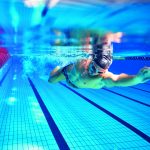Learn all about open water swimming
Long-distance swimming covers all those swimming events held in open water, such as rivers, lakes and seas (which is why it is called open water swimming). It is divided into four categories: middle-distance swimming (up to 5 km), long-distance swimming (up to 15 km), ultra-distance swimming (up to 25 km) and marathon swimming (over 25 km).
Long-distance swimming has become much more popular recently due to the triathlon, which begins with a swim.
Due to the conditions in which they take place, open water swimming competitions are affected by various factors:
Weather factors, such as wind, waves and/or currents, water temperature and density.
Strategic factors, such as deciding whether to swim at the front of the race or in the group, how often to eat and drink during a race.
Environmental factors, such as the distinctive features of courses, either swum over several laps and, therefore, beginning and ending in the same place, or races held in more or less regular stretches of water, which start and finish in different places.
Races held over different distances (from 5 km-25 km), lots of people taking part, long races (over 2 hours) and frequent changes in pace during the race itself….. what comes to mind?
That’s right!! Running competitions!
In actual fact open water swimming races are the most similar to endurance running events. Recent studies (Shephard, Roy, and Per-Olof Astrand. “Chapter 1/p 13 Encyclopedia of Sports Medicine) have shown that there is a correlation in terms of training between open water swimming and endurance running in terms of developing enough stamina to maintain the right pace throughout the entire race.
As we have seen in previous articles, aerobic capacity gradually develops over weeks, months or even years, so it is important to have a carefully worked out plan covering:
- First phase (longest): aerobic-based training and introduction to anaerobic work.
- Second phase: quality training mainly at VO2max* pace.
- Third phase: maintaining your aerobic and anaerobic fitness while increasing your speed.
- Fourth phase: (shortest): rest and attention to detail.
So here is some useful advice for tackling your first open water races as effectively as possible:
1. Mainly train in the pool, because you cannot train under all race conditions. Race conditions always vary and your competitors are never the same, so it is hard to replicate every single variable.
Train at VO2max* or anaerobic threshold pace. This is probably the best way to develop the most efficient swim stroke for racing.
2. Get used to eating and drinking during longer training sessions. This will not only help boost your energy, it will also prepare you for taking on nutrition at race pace. Remember, routine is essential in endurance races, particularly from a mental viewpoint.
3. Train as if you were in “open water”. Swim as if you were in open water by incorporating the following exercises into your training sessions:
- Tarzan drill: 10×50 swimming 25 m freestyle with your head out of the water and 25 m backstroke. Increase the number of reps and distance (75 m or 100 m) as soon as you are comfortable with this kind of swimming. This will help strengthen your neck and teach you how to check for land markers.
- Swimming without underwater turns: swim long sets (from 400-1000 m) without making underwater turns. As you approach the wall, turn without pushing off with your legs using just the strength in your arms and legs.
Remember there is no improvising in swimming, training is the key.
* VO2MAX: WE CAN DEFINE THIS AS A PERSON’S MAXIMUM AEROBIC POWER. IT EQUALS THE MAXIMUM ENERGY UPTAKE THAT CAN BE USED OVER A GIVEN PERIOD OF TIME DURING PHYSICAL EXERCISE AT INCREASING INTENSITY THROUGH TO EXHAUSTION.
Written by:
Luca Borreca
An excellent swimmer when he was young, he then took up first water polo and then finswimming before focusing on teaching swimming. A swimming instructor since 2001, he is now the Head Coach and TD of a famous old Milanese swimming club. He has trained a number of both national and international standard swimmers. A very keen sportsman, he completed his first IRONMAN triathlon in Wales in September 2013.







